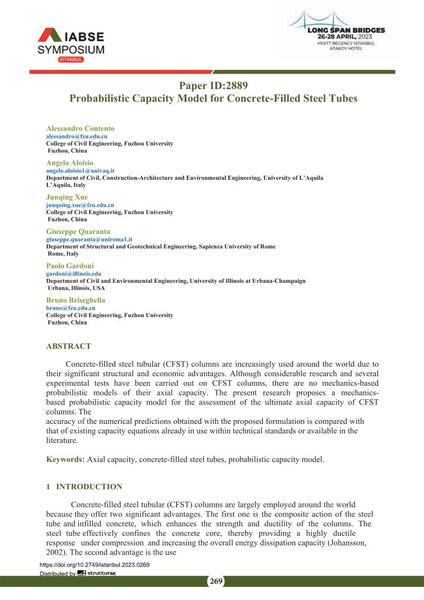Probabilistic Capacity Model for Concrete-Filled Steel Tubes

|
|
|||||||||||
Détails bibliographiques
| Auteur(s): |
Alessandro Contento
(College of Civil Engineering, Fuzhou University Fuzhou, China)
Angelo Aloisio (Department of Civil, Construction-Architecture and Environmental Engineering, University of L’Aquila L’Aquila, Italy) Junqing Xue (College of Civil Engineering, Fuzhou University Fuzhou, China) Giuseppe Quaranta (Department of Structural and Geotechnical Engineering, Sapienza University of Rome Rome, Italy) Paolo Gardoni (Department of Civil and Environmental Engineering, University of Illinois at Urbana-Champaign Urbana, Illinois, USA) Bruno Briseghella (College of Civil Engineering, Fuzhou University Fuzhou, China) |
||||
|---|---|---|---|---|---|
| Médium: | papier de conférence | ||||
| Langue(s): | anglais | ||||
| Conférence: | IABSE Symposium: Long Span Bridges, Istanbul, Turkey, 26-28 April 2023 | ||||
| Publié dans: | IABSE Symposium Istanbul 2023 | ||||
|
|||||
| Page(s): | 269-276 | ||||
| Nombre total de pages (du PDF): | 8 | ||||
| Année: | 2023 | ||||
| DOI: | 10.2749/istanbul.2023.0269 | ||||
| Abstrait: |
Concrete-filled steel tubular (CFST) columns are increasingly used around the world due to their significant structural and economic advantages. Although considerable research and several experimental tests have been carried out on CFST columns, there are no mechanics-based probabilistic models of their axial capacity. The present research proposes a mechanicsbased probabilistic capacity model for the assessment of the ultimate axial capacity of CFST columns. The accuracy of the numerical predictions obtained with the proposed formulation is compared with that of existing capacity equations already in use within technical standards or available in the literature. |
||||
